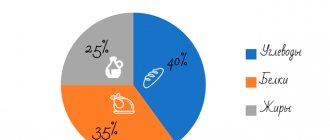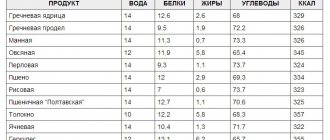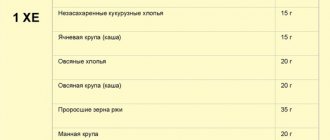This article is about how to count calories correctly and not make mistakes.
By eating by eye, we get results by eye.
Why can't you lose weight or can't gain weight? Do you think you eat like a sparrow when you're trying to lose extra pounds, or like a hungry wolf when you're trying to gain weight? If there is no result from the diet, then your estimate of calorie intake is incorrect. When asked, “How many calories do you get per day?” - you won't have an exact answer.
People tend to underestimate their intake when dieting and overestimate it when they want to gain weight. In this study, people's error in determining their caloric intake on a diet without calorie counting was 50%. Think about it!
Counting calories gives an objective picture of your diet. Yes, it is not 100% accurate, but this is not necessary. At least it is more accurate than by eye, palm, handful or glass.
Counting calories is easy, but there are some nuances. We'll talk about them. How not to make mistakes and take into account the really important details in order to manage your weight as accurately as possible.
It can be difficult at first because you may not be able to correctly count the correct amount of calories in foods right away. The calculation itself at the beginning of the journey will take a lot of time and search, and this can be annoying. After a few weeks of self-monitoring, you will become a pro at estimating the calorie content of foods.
What is basal metabolism?
Calculation of daily caloric intake begins with the calculation of the basal metabolic rate (BMR) - the amount of energy required by the body to support vital processes. The human body, even when at rest, constantly expends calories for breathing, digestion, blood circulation and other physiological processes. The daily caloric intake must be higher than the BMR, otherwise the body will not be able to function normally.
The level of basal metabolism can be determined by two methods: direct and indirect.
In the first case, a person is placed in a special chamber, where the amount of heat he consumes is measured, after which the PBM is calculated. This research method is the most accurate, but at the same time inaccessible.
The indirect method involves calculating basal metabolism using a special formula. Today there are several main methods of calculation. Let's list the main ones.
A simple way to balance your diet for weight loss
Calculating calorie content requires habit and knowledge of the energy value of different foods. It is important not only to adhere to the daily norm, but also not to forget about the quality of the products. Because 500 kcal of fresh vegetables is healthier than 500 kcal of sweets and fast food. You don’t have to weigh the food yourself and create a menu for the week: we offer ready-made balanced meals for the amount of kcal you need. It is not only healthy, but also tasty, which means that there will be no temptation to indulge in foods that are too high in calories.
Balanced nutrition delivery Moscow | Delivery of ready-made food for a week reviews | Proper nutrition to the office delivery | Detox juices with delivery | Fish program at home | Complex for weight loss | Sports food at home | Prepared food for vegans
Harrison-Benedict formula calorie calculation
The formula was developed by the American physiologist Francis Gano Benedict and botanist James Arthur Harris at the beginning of the last century, but still remains relevant. Has an error of about 5%.
The formula for calculating the PBM is as follows:
- For women: 655.1 + (9.563 × weight in kg) + (1.85 × height in cm) - (4.676 × age in years);
- For men: 66.5 + (13.75 × weight in kg) + (5.003 × height in cm) - (6.775 × age in years).
The result obtained is the daily calorie intake required by the body for normal functioning. To calculate how many kcal you need to consume to maintain weight, you need to multiply the resulting figure by the physical activity coefficient:
- 1.2 – minimal (sedentary work, lack of physical activity);
- 1.375 – low (training for at least 20 minutes 1-3 times a week);
- 1.55 – moderate (workouts 30-60 minutes 3-4 times a week);
- 1.7 – high (workouts 30-60 minutes 5-7 times a week; heavy physical work);
- 1.9 – extreme (several intense workouts a day 6-7 times a week; very labor-intensive work).
How to count calories without scales
If you don’t have a kitchen scale for one reason or another, you can count calories using your hands.
Whites = palm
Choose high-protein foods such as meat, fish, eggs and dairy products, beans. Your palm will be a measure of the protein portion per meal (list of foods rich in proteins).
One serving of protein for men
One serving of protein for women
Fat = thumb
Make a diet of high-quality fats of plant and animal origin, for example, vegetable oils, nut butters, nuts, avocados, lard (more about healthy fats). Thumb is a measure of one serving of fat per meal.
Single portion of fat for men
Single serving of fat for women
Carbohydrates = handful
Cup your palms and get one serving of carbohydrates. Carbohydrate foods can be different, but it is important that they satiate you well, for example, fruits, grains and cereal products, buckwheat (read more about carbohydrate foods on a diet).
One serving of carbohydrates for men
One serving of carbohydrates for women
Vegetables = fist
The size of your fist will be the serving of vegetables in your meal. Choose non-starchy vegetables such as tomatoes, cucumbers, greens, lettuce, broccoli, spinach, carrots, cabbage.
One serving of vegetables for men
Single serving of vegetables for women
The above photos show one meal for men and women. For both sexes, 4 such meals per day are needed to maintain weight. To lose weight, remove one finger of fat or one palm of carbohydrates from any food.
This form of meal planning is a starting point, just like counting calories on a scale. Stay flexible and adjust your portions based on your hunger and your weight loss results.
Calorie calculation using the Mifflin-San Geor formula
The method for calculating daily caloric intake was developed by nutritionists under the guidance of doctors Mifflin and San Geor. The formula was developed relatively recently, but today it is the most accurate. It helps to calculate the required amount of kcal for a person aged 13 to 80 years.
Simplified version (without taking into account physical activity)
- For women: (10 x weight in kg) + (6.25 x height in cm) – (5 x age in g) – 161;
- For men: (10 x weight in kg) + (6.25 x height in cm) – (5 x age in g) + 5.
Body Mass Index Calculator
Body mass index is an indicator indicating the presence or absence of excess body weight, allowing one to determine the percentage of fat content. Calculations are made based on individual data. In particular, you will need to indicate your height, weight, and age. After the calculations, the program will report the results. In particular, the optimal weight will be indicated, as well as data on the presence or absence of excess weight. Having the data obtained, you can later understand the algorithm of actions to eliminate existing problems.
- Female Male
- Body mass index:
- Weight should be in the range:
- Ideal weight:
- Body fat:
Result
Advantages
The program is optimal for those who have decided to lose weight and for the first time are faced with the task of calculating the consumption norms of CBJU. Based on the data obtained, you can plan a weight loss schedule so that you don’t try to get in shape by jumping on a strict diet, but lose weight correctly, without stressing the body. The program has the following set of advantages:
- Ease of use – you do not need to have specific data to determine optimal indicators and excess weight maintenance;
- Accurate result - calculations will allow you to obtain accurate indicators that can be used in the future;
- Automatic result - you don’t need to create a calculation formula, as professional nutritionists do, everything is automated and by entering the necessary data, you will immediately get the finished result.
Knowing your BMI is the first step towards losing weight. The application is universal, suitable for women and men, regardless of age and other indicators.
Features of work
Please note that this application allows you to obtain accurate, but still averaged data and is suitable for people who want to lose weight and have not previously led a sports lifestyle. For example, with a height of 180 cm and a weight of 90 kg, a professional athlete and a person who has never played sports, the volume of fat and muscle tissue can vary significantly. Therefore, the program is primarily aimed at providing an average, optimal result for people leading a normal lifestyle.
Further calculations of KBZHU must also be built taking into account the energy expended daily, and if you plan to start actively playing sports, then their number will increase significantly due to more active burning. This must be taken into account when preparing your daily diet and selecting dishes for your table.
World Health Organization (WHO) formula
The World Health Organization provides recommendations on how to calculate your daily caloric intake:
- For women from 18 to 30 years old (0.062 x weight in kg + 2.036) x 240 x CFA;
- For women from 31 to 60 years old (0.034 x weight in kg + 3.538) x 240 x CFA;
- For women over 60 years old (0.038 x weight in kg + 2.755) × 240 x CFA;
- For men from 18 to 30 years old (0.063 x body weight in kg + 2.896) x 240 x CFA;
- For men from 31 to 60 years old (0.484 x body weight in kg + 3.653) x 240 x CFA;
- For men over 60 years of age (0.491 x body weight in kg + 2.459) x 240 x CFA.
Where CFA is the coefficient of physical activity: 1 - low, 1.3 - average, 1.5 - high.
The Importance of a Calorie Deficit for Weight Loss
For weight loss, the most important factor is a calorie deficit. This factor does not depend on any conditions: neither on diets, nor on fashion trends in nutrition... If the goal is to lose excess weight, then the main condition here is a calorie deficit. Regardless of how you eat—whether cutting carbs, eliminating fat, or practicing intermittent fasting—you must be in a calorie deficit to experience weight loss.
A kilogram of body fat contains about 7,700 calories. Studies have shown that losing weight by 0.5-1 kilograms per week is safe.
How to properly reduce daily calorie intake to lose weight?
For harmonious and safe weight loss, it is recommended to reduce the caloric content of the diet, taking into account physical activity, by 10-15% (by 20% for severe obesity). The daily calorie content should not be lower than the following indicator:
Weight in kg/0.45 x 8
WHO recommends reducing food intake by 500 kcal per month from the actual diet until the calorie content is 300-500 kcal below the daily requirement.
Reducing the daily intake by 500 kcal per day leads to a loss of approximately 500 grams of fat mass per week. After six months of such weight loss or upon reaching your ideal weight, it is recommended to recalculate the daily calorie intake taking into account new indicators.
You shouldn’t cut your calorie intake as much as possible to lose weight more effectively. A loss of 250-500 grams per week is considered physiological and safe for health. Exceeding these numbers means loss of muscle and fluid.
How to count KBJU dishes
Calculating the calorie content of a finished dish at a certain level of dexterity is easy and accessible to everyone.
Let's look at the calculation of KBZHU using a simple example: let's cook dietary crumbly buckwheat porridge.
The calorie content of 100 g of buckwheat is 340 kcal, BZHU: 13 / 3.5 / 64.
From 200 g of cereal (calorie content 680 kcal) you get 400 g of ready-made porridge (same calorie content 680 kcal), BZHU: 26 / 7 / 128.
Formula for calculating calories in one serving of a prepared dish:
BZHU is considered similarly.
For example: By eating a 150-gram portion of delicious buckwheat at a time without oil and other additives, you will get
680 kcal / 400 g x 150 g = 250 kcal, BZHU 9.75 / 2.63 / 48.
- To calculate the calorie content of a complex dish made from a large number of ingredients, you need to weigh all the ingredients before cooking, determine their energy capacity and add up the results.
The calorie content of a vegetable salad is calculated as follows:
tomatoes 300 g, 54 kcal, BJU: 2.64 / 0.6 / 8.07;
cucumbers 300 g, 45 kcal, BJU: 2.4 / 0.3 / 8.4;
lettuce 100 g, 15 kcal, BJU: 1.36 / 0.15 / 2.79;
radish 50 g, 10 kcal, BJU: 0.6 / 0.05 / 1.7;
olive oil 15 g, 135 kcal, BJU: 0 / 14.97 / 0.
Total weight 765 g, total calorie content 259 kcal, BJU: 7 / 16.07 / 20.96.
The calorie content of a 200-gram serving will be: 259 kcal / 765 g x 200 g = 68 kcal
Proteins: 7 g / 765 g x 200 g = 1.83 g,
Fat: 16.07 g / 765 g x 200 g = 4.2 g,
Carbohydrates: 20.96 g / 765 g x 200 g = 5.5 g.
It is important to note that when calculating, only the weight of the finished product is used, and not the total weight of all components.
As you can see, counting calories is not that difficult. The main thing is to start. Over time, you'll get used to weighing ingredients before cooking and portions before eating, and always keeping a calculator handy.
Proteins, fats and carbohydrates when counting calories
Effective weight loss is not only about maintaining daily calorie intake, but also about proper distribution of proteins, fats and carbohydrates. A balanced diet according to the BJU ratio will look like this:
- For weight loss: 30-35% proteins, 30-35% fats, 30-40% carbohydrates;
- To maintain weight: 25-35% proteins, 25-35% fats, 40-50% carbohydrates;
- For weight gain: 35-40% proteins, 15-25% fats, 40-60% carbohydrates.
With this distribution of BJU in the diet, the body receives sufficient quantities of nutrients and vitamins.
Do not forget that all formulas for calculating daily calorie content may have errors. They do not take into account the percentage of food absorption, health status, metabolic rate and other factors. Even a diet compiled by a specialist may not work in a particular case due to the individual characteristics of a person. In the process of building a beautiful, strong body, you should listen to your feelings, and, if necessary, change your diet and the ratio of KBJU.
Watch your diet, exercise, and the results will not take long to arrive!
Calculation of calories per day
Why do you need to calculate the number of calories per day?
The answer is simple - in order to maintain, gain or lose weight, you need to know how many calories your body consumes. If you want to lose weight, you need to burn more calories than you consume. You only get calories if you eat or drink something. And you have to constantly spend calories - on the work of the body itself, on physical and mental stress.
Average number of calories per day
In general, women require 1500-2000 calories to maintain weight. For men, this value is higher - 2000-2500 calories.
How many calories do you need to lose weight or gain weight?
Using an online calculator, you can calculate the calorie needs that you need for your existence, and calculate the number of calories for losing weight, gaining or maintaining weight. Calories are calculated based on weight, height, age and activity. Based on the data received and your desired weight, the calculator will calculate the number of calories you should consume per day to lose, gain or maintain weight. As a rule, calculations are made using several methods that will show an approximate range. This is done to minimize the error of each individual calculation method.
Minimum calories per day for weight loss
The calculation of the number of calories is shown in the “Weight loss” column. "Extreme Weight Loss" will show you the minimum possible calorie values for reference, but it is not recommended to use them. If you reduce your calorie intake below the minimum, your body will begin to burn not only fat, but also muscle to obtain energy. The metabolic rate will drop and even a slight excess of calories will be stored by the body. In addition, muscles consume several times more energy than fat cells. Therefore, burning muscles does not lead to positive results.
Zigzag calories
The calculation results contain a table for calculating calories by day, the so-called “zigzag”. It is believed that the best results are obtained if you vary your daily caloric intake slightly, maintaining an average value.
How to count kilocalories
A kilocalorie is one thousand calories. One calorie is how much energy is required to heat 1 ml of water by 1 degree. But there is also a food or dietary calorie, which is equal to a kilocalorie. Product packaging may indicate the calorie content of products as either “kkak” or “cal”, and this will be referred to as kilocalories.
Calorie calculation example
Anna, office worker, two children. Does household chores when not at work. He goes in for sports three times a week. Height 163 cm, weight 65 kg, age 35 years. Wants to reduce weight to 57 kg. According to the Mifflin-San Jeor formula, the daily calorie consumption will be 1833 kcal, on average 1918. To lose weight, Anna needs to reduce her daily calorie intake by about 500 calories per day, that is, consume 1400 kcal.
Should you eat the same amount of calories?
You can stick to the same number of calories per day, or you can move 200-500 calories to the previous or subsequent day from the day of training. Also, if your weight suddenly stops (weight plateau), then consuming calories according to the Zigzag pattern will help move it off the ground.
Is it possible to lose weight only on a diet?
You can lose weight, but when you reduce your daily caloric intake, a person loses not only fat, but also muscle. Try to lead a more active lifestyle, do exercises, add small physical activities
Weight loss rate
Recommended weight loss per week is no more than 1 kg. A high rate of weight loss will lead to worse appearance, poor health, stress on the body, and fatigue.
Weight gain rate
The ideal amount for increasing muscle mass is 1 kg per month for men and 0.5 kg per month for women. A large increase will lead to an increase not only in muscle, but also in fat.
Should I drink water?
Drinking clean water is necessary when losing weight.
Warning
All calculations are based on mathematical and statistical formulas. But only a doctor can give an accurate assessment and recommendations. Please consult your physician before starting a diet or changing your exercise level.
How to determine your activity level
Activity level chart
Weight standards
Before calculating what calorie deficit a person needs to lose weight, you need to know what a weight norm is and how it is calculated. There are several basic formulas by which norms are calculated.
- For a non-athletic person, a height of 110 is considered normal weight.
- For athletes, a formula is usually used in which the weight is calculated to be 10 kilograms more than usual.
Note: despite the fairly close approximation of these formulas, if you look at CrossFit athletes, their weight is really in the range of height -100+-5 kilograms. The same Richard Froning, with a height of over 180 centimeters, at the peak of his career weighed only 85 kilograms.
Naturally, this approach is not completely correct, since it does not take into account many factors, including:
- Initial metabolism.
- Weight and bone thickness, which can adjust weight by 8 kilograms in any direction.
- Amount of muscle mass.
- The amount of glycogen in the blood.
- Fat percentage.
In particular, we may see two people of the same weight who will look completely different. Therefore, when calculating the optimal weight, we will use more advanced statistical formulas.
© elenabs — depositphotos.com. BMI is a weight reference for people who do not exercise
For men
How to calculate normal weight for a man, and determine whether he needs to create a calorie deficit to lose weight? On average, a weight of 75-80 kilograms is considered the norm for an active man. No matter how strange it may be, this figure practically does not depend on a person’s height. On average, people who are shorter have a thicker bone structure, which puts them on par with tall and thin people. The normal amount of adipose tissue for a non-athlete is considered to be up to 22% with its even distribution throughout the body. If you have a large muscle mass (for mesomorphs), the value of adipose tissue can be up to 30%, and the person will still not be considered fat or overweight. In general, it is necessary to measure the percentage of fat tissue and its ratio to muscle volume.
Interesting fact: Ronnie Coleman, at the peak of his career, failed the police exam because he was considered overweight and classified as terminally obese. At the same time, this fact was recorded almost immediately after the Olympia, when the total body fat barely reached 10%.
© sasha_zerg — depositphotos.com
For women
In the case of women, two factors need to be used at once.
- Height/weight ratio. It should be standard (height -110).
- Body fat percentage.
In the case of his calculations, women are given certain concessions. Since their body is configured to store energy in case of childbirth or hunger, the normal distribution for a woman who is not an athlete is considered to be 23-24% of the tissue.
© sasha_zerg — depositphotos.com
For athletes
Calculating normal weight for athletes is complicated by many features:
- Type of sports discipline.
- Body type.
- Determination of glycogen levels.
For example, serious bodybuilders need to maintain a high percentage of body fat in the off-season (up to 30%), as it allows them to:
- Increase the synthesis of the hormone testosterone.
- It is a shock absorber and lubricant for ligaments and tendons.
At the same time, in the period before the competition, they dry out their body to 4-8% fat tissue. Such fluctuations in weight and percentage of fat tissue are unhealthy, and are achieved exclusively through a set of extreme fat burning during a cutting course (6-10 weeks), after which they return part of the mass. For athletes of other specialties, the weight norm is calculated so that the total percentage of body fat is less than 16%.
© Improvisor — depositphotos.com
How to use an online calculator
The application has a simple and user-friendly interface. To calculate the nutritional value of food, you should indicate the weight of the serving in grams and select the dish of interest from the list provided, after which detailed information about the quantity contained in it will appear on the screen:
- calories;
- proteins;
- fats;
- carbohydrates.
To make it easier for the user to find the information of interest, the application provides a search by name. When working with the program, you need to specify the name of the product in a special window, after which the system will automatically select from the list all results that meet the search conditions.
Considering that when eating a person rarely limits himself to one product, the application allows you to simultaneously calculate the indicators of several dishes, as well as determine their total energy value.
Attention! If you cannot find a product or dish, then try rephrasing the query, for example, instead of “fried potatoes” type “fried potatoes”, instead of “herring under a fur coat” type “herring under a fur coat”, etc.
Lifehacks
One of the main life hacks that will allow you to painlessly create a calorie deficit for weight loss is the consumption of caffeine-containing drugs. It can be:
- Actually coffee.
- Strong tea without sugar.
- Energetic drinks.
- Decoctions from ginger root.
- Pre-workout complexes.
Note: green coffee is not particularly effective at burning fat, like other very specific foods.
Why does drinking coffee increase fat burning? Everything is very simple. Drinking in large doses (no more than 2 cups in 2 hours), caffeine affects the body as follows:
- Increases heart rate. This increases passive kcal expenditure.
- It opens the fat depot, the excess energy of which goes into the general bloodstream. The body strives to spend such an excess of energy as quickly as possible.
- Creates an insulin surge in the absence of sugar.
- Increases energy, and therefore calorie consumption in certain cases.
Another interesting life hack is to increase the number of meals, which allows you to trick the body for a short time. As a result, even with a severe calorie deficit (up to 80% of the norm), the body does not slow down metabolism, but with the help of insulin releases, it opens a fat depot, from where excess energy passes directly into the blood, accelerating weight loss.
With extreme diets, the recommended number of meals is considered to be 5 or more.
Calculation of nutritional deficits
How to correctly calculate nutritional deficits. Everything is very simple, even if you decide to create an extreme deficit, remember the simple rules:
- Calculate calorie consumption.
- Subtract a percentage for your goals (10 to 75).
- Divide the resulting calorie content into 5-7 meals.
- Choose foods with a minimum glycemic index and high digestion time.
- Use an abundance of protein and fiber to maintain basic body functions.
Calorie consumption example
Based on the tabular data, we will calculate the approximate consumption for a person with an athletic build (up to 20% fat tissue) weighing 75 kilograms. The net weight of such a person is 60 kilograms.
- Sleep 8 hours – up to 720 kcal. Why so much? Everything is very simple. During sleep, the body rearranges all functions, launches intense anabolism, and in some phases of sleep, on the contrary, catabolic processes begin.
- High intensity training – 1 hour – 1080 kcal.
- Office work – 8 hours – 576 kcal.
- Meals (5 pieces) for 15-20 minutes. -60-80 kcal.
- Walking to work and back – 1 hour 210 kcal.
- Gaming – 2 hours a day – 100 kcal.
- Passive consumption – 720 kcal.
The total consumption, not counting small activities, is 3500-3700 kcal. To create the correct deficit, it is necessary to limit food to 3000-2800 kcal. In the absence of training, the consumption per day is 2500-2700. Accordingly, nutrition on days without training is 2000-2200 kcal.
Recipes for healthy eating
Beets stewed with onions
- 1.6 g Protein
- 4.1 g Fat
- 9.9 g Carbohydrates
- 85.2 kcal
30-35 min.
- #vegetarian dish
- #dietary
- #for vegans
- #greenery
- #ground ginger
- #low calorie
- #dinner
- #vegetables
- #paprika
- #vegetable oil
- #onion
- #beet
- #dinner
Other recipes











